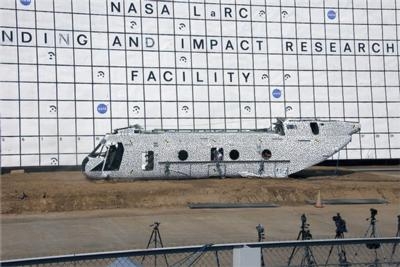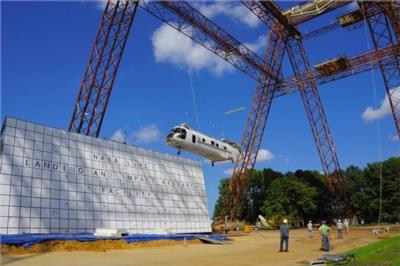Airframe Fitted With Sensors And Crash Test Dummies Dropped To Help Improve Accident Survivability
The successful crash test of a former Marine helicopter could help lead to safer civilian and military helicopters, according to NASA aeronautics researchers.

The full-scale test sent the fuselage and its 15 dummy occupants crashing into the dirt at NASA Langley Research Center's Landing and Impact Research facility in Hampton, Virginia , at about 30 miles an hour.
"This was actually our second crash test of the same type of airframe," said lead test engineer Martin Annett. "The two drops were done under very similar conditions, but the results were not the same. This helicopter crash was a lot different from last year, just the way that it came in and almost came to an abrupt stop."
The CH-46E Sea Knight fuselage hit hard on impact and slid only a few feet. The 13 instrumented crash test dummies and two non-instrumented manikins "felt" the jolt. The data will take months to analyze, but preliminary observations indicate there was severe damage to the floor and seats - more than last year. "We think there were a lot higher loads in the longitudinal direction," said Annett. "That's forward and back."
The Transport Rotorcraft Airframe Crash Test Bed or TRACT 2 test was a collaboration between NASA, the U.S. Navy, U.S. Army, the Federal Aviation Administration and two international organizations. In August of 2013, NASA evaluated a number of crashworthy concepts – seats, restraints and the type of crash test dummies used to certify equipment inside aircraft. The big difference this year was that researchers took some metallic components out of the airframe subfloor and replaced them with lightweight composites to see how the would perform under the same type of impact conditions.
"One of the things we noticed was there was a high shearing action that almost slipped the entire floor, instead of crushing the subfloor like we anticipated," said Annett.
Cables hauled the helicopter fuselage 30 feet up in the air and then swung it to the ground, much like a pendulum. Just before impact pyro-technic devices released the suspension cables from the helicopter to allow free flight.
Almost 40 cameras inside and out and computers on board with 350 data channels recorded every move of the 10,500-pound fuselage and its "passengers." Even the helicopter's unusual black and white speckled paint job contributed to the data collection. It was for a technique called full field photogrammetry. High-speed cameras filming at 500 images per second tracked each dot, so after the drop researchers can plot and see exactly how the fuselage buckled, cracked or collapsed under crash loads. All the cameras are an important part of the test.

"The data from the acceleration, motion and loads only tells half the story," said test engineer Justin Littell . "It teaches you a lot about what happens. The cameras show how and why things happen. The high speed video data from the on board high speed cameras will be crucial in telling us exactly what happened with the floor and the shearing action."
For this test NASA supplied six crash test dummies, built two composite subfloor concepts and installed four emergency locator transmitters that researchers are evaluating. The Navy provided the CH-46 Sea Knight helicopter fuselage, seats, crash test dummies and other experiments. The US Army Aeromedical Research Lab (USAARL) contributed a litter experiment and the Army CH-47 program office ( PEO CARGO ) provided a crash resistant troop seat.
The Federal Aviation Administration provided a side-facing specialized crash test dummy and part of the data acquisition system. Cobham Mission Systems also contributed an active restraint system for the cockpit. The German Aerospace Research Center (DLR) and the Australian Cooperative Research Center for Advanced Composite Structures supplied a third composite subfloor technology.
The tests are part of the Rotary Wing Project in the Fundamental Aeronautics Program of NASA's Aeronautics Research Mission Directorate. NASA will use the results of both tests in efforts to improve rotorcraft performance and efficiency. Researchers also want to increase industry knowledge and create more complete computer models that can be used to design safer helicopters.
The ultimate goal of NASA rotary wing research is to help make helicopters and other vertical take-off and landing vehicles more serviceable -- able to carry more passengers and cargo -- quicker, quieter, safer and greener.
(Images provided by NASA)
 ANN's Daily Aero-Term (04.25.24): Airport Rotating Beacon
ANN's Daily Aero-Term (04.25.24): Airport Rotating Beacon ANN's Daily Aero-Linx (04.25.24)
ANN's Daily Aero-Linx (04.25.24) Klyde Morris (04.22.24)
Klyde Morris (04.22.24) Airborne 04.24.24: INTEGRAL E, Elixir USA, M700 RVSM
Airborne 04.24.24: INTEGRAL E, Elixir USA, M700 RVSM Airborne 04.22.24: Rotor X Worsens, Airport Fees 4 FNB?, USMC Drone Pilot
Airborne 04.22.24: Rotor X Worsens, Airport Fees 4 FNB?, USMC Drone Pilot




